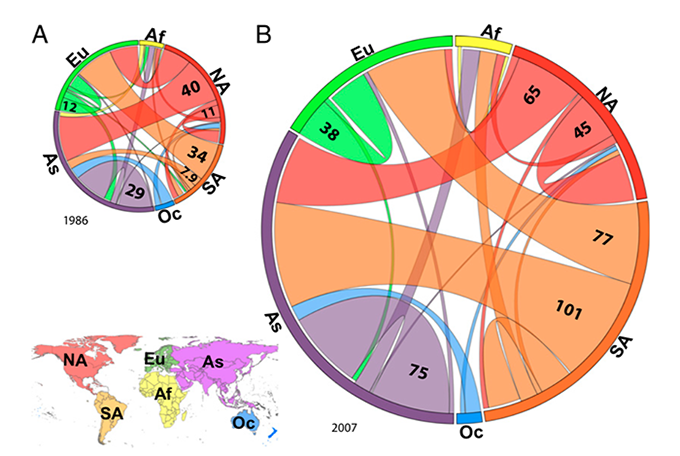FAOSTAT indicates that in 2017 global crop production was sufficient to feed approximately 7.4 billion people a diet of over 2900 kcal per person per day. This is well above the FAO recommended minimum of 2400 kcal per person per day, enough to eliminate undernourishment if the food could be distributed equitably. However, the current high rate of undernourishment (10%) indicates that the extra food produced in areas of surplus is not reaching people in areas of shortage. Trade and food aid make it possible to redistribute crops and the resources needed to grow them. In this class we examine the role of international food trade as well as local reallocation of natural resources to better reconcile regional differences in food supply and demand.
We begin with the paper by D’Odorico et al. (2014), which explores how trade improves food security. It uses FAOSTAT national production, trade, and crop calorie data for 2009 to determine that about one fourth of the 2009 global population was fed on imported food in that year. The exact figures depend on the way that total crop production is distinguished from the quantity actually consumed. However, it is clear from the analysis that trade plays a major role in meeting global food demand. The paper provides maps that show how calories flow from the small number of major exporters to the much large number of importing nations.
Additional insight is provided by MacDonald et al. (2015), who evaluate the quantity of virtual (or embodied) natural resources transferred geographically through trade. The paper looks at agricultural trade in terms of calorie content, cropland and pasture area, and irrigation volume transferred from exporting to importing countries. The attached figure from the optional reading by Dalin et al. (2012) shows how virtual water transfers between continents increased from 1986 to 2007. Similar calculations could be made, but are not included in the paper, for nutrients, pesticides, labor, and other inputs. It is notable that trade alleviates imbalances in food supply and demand at the expense of exporting virtual resources, including water, that may be in short supply in the exporting region.

© PNAS. All rights reserved. This content is excluded from our Creative Commons license.
For more information, see https://ocw.mit.edu/help/faq-fair-use.
An alternative to reallocating (virtual) resources through food trade is to reallocate actual land and water resources by changing the crops and irrigation diversions assigned to individual parcels of cropland. The idea here is to optimize the allocation of land and water to crops with respect to an appropriate measure of benefit, such as net revenue or number of people fed, or to minimize a cost measure, such as water used or imports required. An example is discussed in the paper by Davis et al. (2017), who use a sequential replacement algorithm to discover crop patterns that reduce irrigation (“blue”) water use without reducing calorie or protein production, farm revenue, or crop diversity. The authors estimate that the crop allocation changes outlined in their paper will feed over 825 million more people while saving water. However, this requires dietary changes (e.g. eating more legumes and fewer cereal crops). Reallocation of crops and water to land helps because it improves on the existing cropping strategy, which does not necessarily optimize resource use. Although the particular dietary and cropping changes suggested in this paper may be difficult to implement, the analysis does indicate what could be achieved if land and water resources were used more efficiently.
Required Readings
Trade and Food Security
- Paolo D'Odorico, Joel A. Carr, et al. 2014. "Feeding Humanity Through Global Food Trade." Earth's Future, 2, no. 9: 458–469.
Trade and Virtual Resource Transfers
- Graham K. MacDonald, Kate A. Brauman, et al. 2015. "Rethinking Agricultural Trade Relationships in an Era of Globalization." BioScience, 65, no. 3: 275–289.
Optimal Allocation of Natural Resources
- Kyle F. Davis, Maria C. Rulli, et al. 2017. "Increased Food Production and Reduced Water Use Through Optimized Crop Distribution." Nat. Geosci. 10, 919–924.
Optional Reading
Trade and Virtual Resource Transfers
- Carole Dalin, Megan Konar, et al. 2012. "Evolution of the Global Virtual Water Trade Network." Proceedings of the National Academy of Sciences, 109, no. 16: 5989–5994.
Discussion Points
- Considering the D'Odorico et al. and Sen (Class 1) papers, why hasn’t trade eliminated malnutrition? What are the barriers that are preventing more food from getting from regions of surplus to regions of shortage?
- What incentives do you think could prompt growers to make the changes needed to “optimize” crop distributions, as outlined in the Davis et al. paper? How reasonable is it to use models and optimization procedures to guide resource use? Do we have better alternatives?
